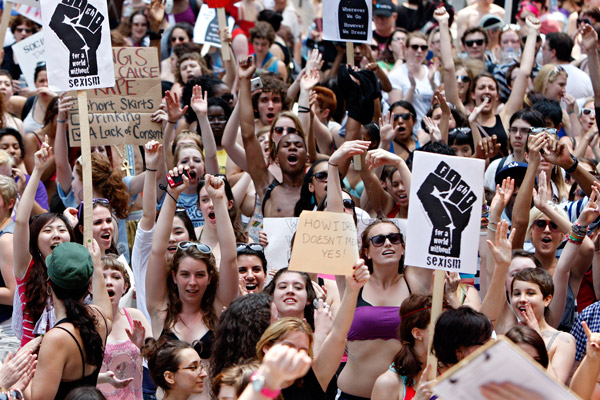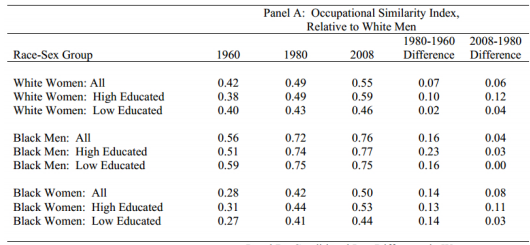
Brian Casesella/Chicago Tribune
In an article exhorting men to "lean in" and pick up the diapers, Catherine Rampell writes something that kind of shocked me:
I happen to be an educated young woman who loves her job, sometimes gushingly, occasionally annoyingly. And yet, even in this enlightened age, I’ve had two relationships end — at least in large part — thanks to that clammy-palmed discussion in which couples plot hypothetical milestones and life goals. The gentlemen in question said that, somewhere in our semicharted future, they expected me to quit my job. At least for a couple of years, anyway, in order to be the kind of hypothetical mother they wanted to raise their hypothetical kids, if that hypothetical day ever came.
Rampell appears to be a bit younger than me, yet it never would have occurred to expect my wife to quit her job just because of her gender. It's not that I was exposed to a particularly intense form of feminism growing up; it's that my mother worked, and her mother worked. I got my work and career ethic from my mother—working's just what you do.
I was surprised because, on the whole, things have changed. And as Rampell writes, those changes have had salutary effects on the American economy:
It’s hard to quantify exactly how much human capital is being wasted, but one clue lies in a study by economists at the University of Chicago and Stanford. It estimates that 15 to 20 percent of American productivity growth over the last five decades has come from more efficient allocation of underrepresented groups, like women, into occupations that were largely off-limits, like doctors or lawyers.
I dug up the study, which looks at the economic changes in the American workforce led by feminism and the Civil Rights movement. The other underrepresented group in the study is blacks. The general concept is this: underrepresentation of women and blacks in the workforce, whether through discrimination or societal mores, represents terrible resource allocation, because some of those women and blacks are going to be good at jobs that had previously been almost exclusively limited to white men.
In 1960, 94 percent of doctors were white men. That distribution should raise an eyebrow, not just in terms of fairness but for its sheer lack of efficiency and productivity. In 48 years, that figure dropped 32 percent. As the authors soft-pedal it, "the occupational distribution in 1960 suggests that a substantial pool of innately talented blacks and women were not pursuing their comparative advantage." Once they started "pursuing" their "comparative advantage," the authors found, talent ceased to be so ridiculously misallocated. Productivity jumped.
And there's even more interesting stuff than what Rampell refers to. For instance:
Furthermore, essentially all of the gain is driven by the movement of women into high-skilled occupations. We infer that changes in occupational barriers may have raised real wages by roughly 40% for white women, 60% for black women, and 45% for black men, but lowered them by about 5% for white men.
But these changes haven't been even over time. Here's what the changes look like:

"Occupational similarity index" compares the sorts of jobs people do. A value of one means everyone's basically doing the same stuff, proportionally speaking. Zero means men and women, black and white, work in completely different fields. If you assume that innate talent is equally distributed, in a world where everyone had identical opportunity the similarity index would be one.
From 1960 to 1980, occupational similarity converged quickly towards one for black men and black women. Then for black men it ground to a halt—literally, in the case of low-educated black men. The only group to increase that convergence after 1980 is high-educated white women.* Whether that has to do with culture or social policy, or whether it becomes harder to make gains as you approach a value of one, the authors don't say. But they do offer a suggestion:
Blacks accounted for a larger share of the gains in the 1960s and 1970s than in later decades. From 1960 to 1980, reduced frictions for blacks account for over 40% of the overall gains. From 1980 to 2008, reduced frictions for blacks account for less than 15% of the overall gains. This timing might link the gains for blacks to the Civil Rights movement of the 1960s.
In other words, the Civil Rights movement had a head start. It reminded me of something Coretta Scott King said, as quoted by Hampton Sides in Hellhound on His Trail: "Martin [Luther King, Jr.] had, all through his life, an ambivalent attitude toward the role of women. On the one hand, he believed that women are just as intelligent and capable as men and that they should hold positions of authority and influence…. But when it came to his own situation, he thought in terms of his wife being a homemaker and a mother for his children. He was very definite that he would expect whoever he married to be home waiting for him." And it was a matter of tension in their marriage. Even for Martin Luther King—whose struggle for genuine equality meant economic equality—much less Rampell's beaus, the role of women in work and in the world fell hard on his own home.
* Differences in the occupational similarity index remain greatest for low-educated women, black and white, while in the past couple decades high-educated black and white women have made the most gains by that metric; class issues have long been a point of contention in feminism, as Barbara Eherenreich wrote in 1999. See also Anna North's piece on pregnancy and job discrimination in low-wage work, and my roundup of how maternity and paternity leave are treated in the United States versus European countries, which comes up in Rampell's article.



